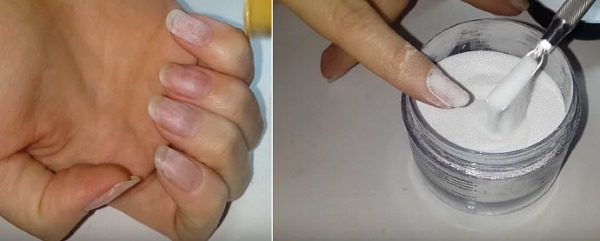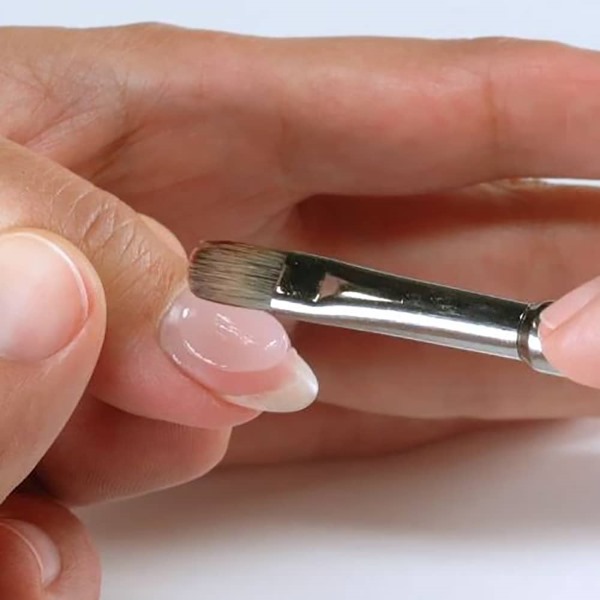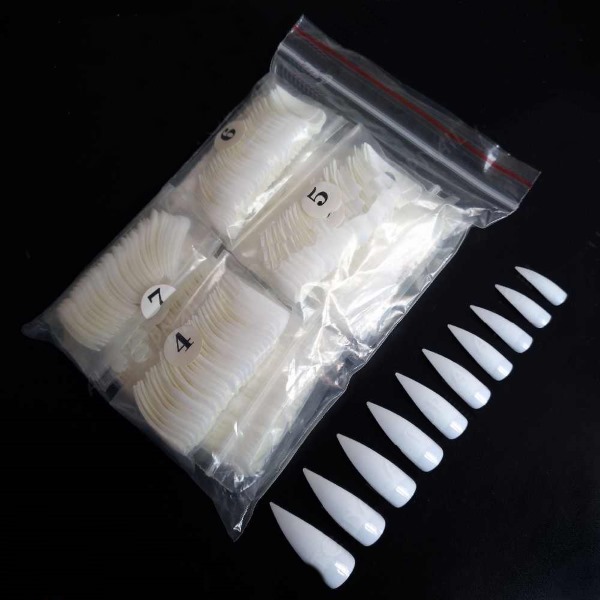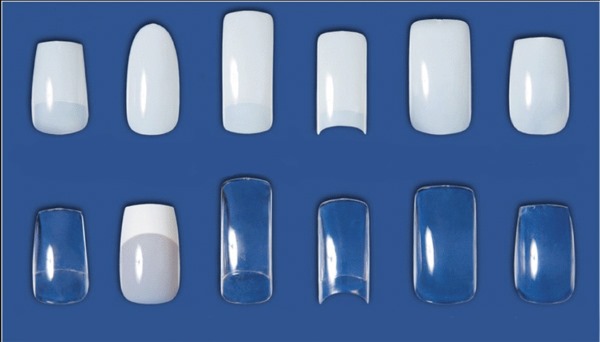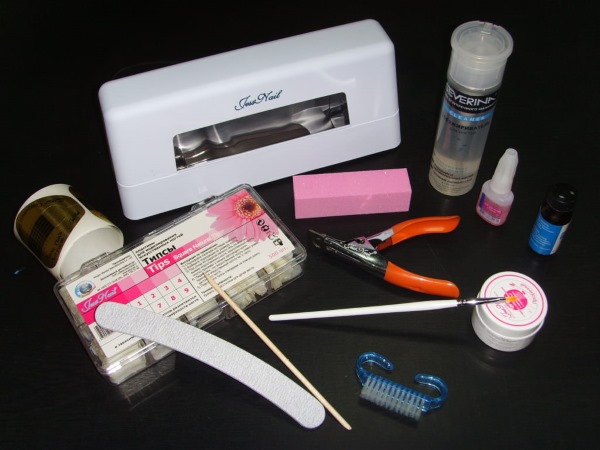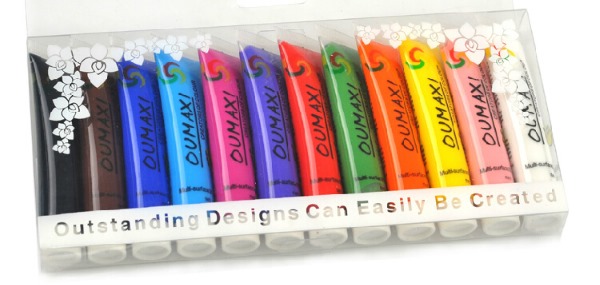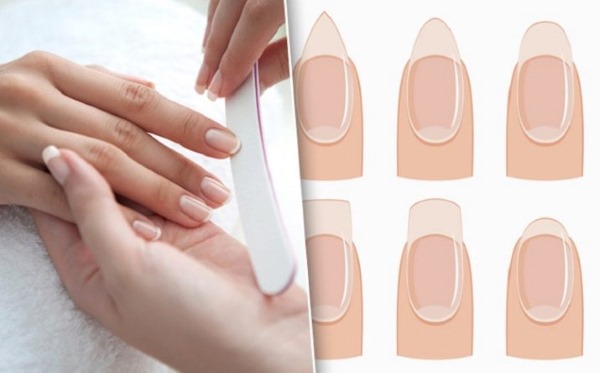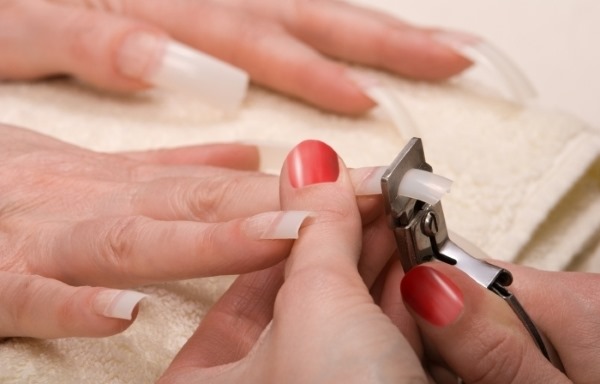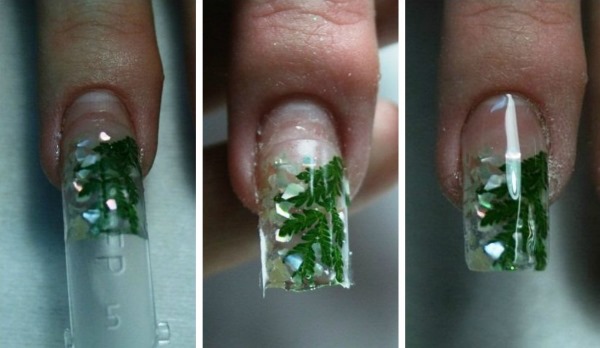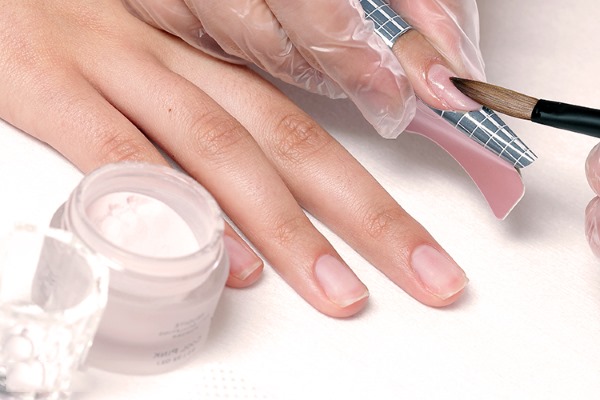Part of a woman's image is well-groomed, beautiful nails. They reflect the taste, style and inner world of the fair sex. Beauty salons provide the services of a master, but more and more girls are using their ideas for nail extension.
What to choose and materials
Different materials are used in the extension procedure: gel and acrylic, forms and tips. To choose the right option, it is important to know their advantages and disadvantages. Differences are present both in properties and in building technology.
Gel or acrylic
The obvious advantages of acrylic include:
- The material is elastic and dense. Working with it, it is easy to create a volumetric design and achieve original three-dimensional shapes.
- The density of the raw materials allows you to effortlessly deduce the intended shape. He does not "float" on the nail.
- The polymerization process does not require special equipment and will take no more than 5-7 minutes. Thanks to this property, acrylic masters are able to cope with the flow of customers spending a minimum of time.
- To remove acrylic from the nail, it is enough to place it in a special solution.
The disadvantages of acrylic are:
- Unpleasant, pungent odor. The feeling of "scent" from acrylic scares off clients, creating the illusion of its harmfulness to health. Therefore, the practice of refusing to work with the material on the part of the masters. In fact, gel and acrylic belong to the same "chemical family" and are similar in composition.
- Fast polymerization simultaneously with pluses in the hands of a professional becomes a minus in the hands of a beginner. The inability to instantly shape the nail plate makes it impossible to further correct it completely, or the beginner has to remove all the irregularities with a file. For the same reason, acrylic is difficult to use on its own at home.
- The material is devoid of a glossy effect. To add shine, the nail needs to be covered with varnish or top, which makes it heavier.
Advantages of the gel:
- On the market of raw materials for nail extension, gel is represented by various brands. It is possible to select the required consistency and density.
- Thanks to self-leveling, both professionals and beginners can use this material in their work. It is distinguished by its even lining (without the presence of tubercles), in contrast to acrylic.
- Throughout the entire period of operation of the manicure, the gel retains its gloss and does not require sanding or additional coating to add shine.
- The absence of odor allows the use of raw materials in beauty salons, in manicure points of shopping centers, at home.
- Drying requires the use of a lamp. The gel does not air dry on its own like acrylic does. You can use the polymerization time to create a figure.
Disadvantages:
- Liquid consistency. The material spreads over the nail, does not hold the figure, does not retain volume.
- The building process involves 3 phases and the use of special means for drying.This is directly related to the loss of time. Each nail takes at least 3 minutes.
- The main negative quality of the gel is fragility. Because of this disadvantage, acrylic is preferred.
Everything for nail extension, and first of all raw materials, should be chosen based on your own feelings (smell, presence of allergies to the material, the severity of the nail).
Forms or tips
The forms are made on an adhesive basis and are pieces of paper for fitting under the nail.
The tips have a plastic base and are attached to the edge of the biological nail. These are 2 types of underlays for building with gel or acrylic.
Tips are preferred for the following reasons:
- Tips are a ready-made form. Working with such a base is less laborious.
- Suitable for brittle and prone to delamination nails, adhere even to biological material that is broken at the root.
The disadvantages of tips are:
- The finished nail, in contrast to the product on the form, looks flatter.
- Not all models can be implemented on the basis of tips, they limit the possibilities of manicure.
- Not everyone is able to create a beautiful nail on a tips basis. They do not lend themselves to compression, especially helium ones. The result of the work is devoid of grace, it looks wide and massive.
- The extension technology using tips is not suitable for wide nails and growing down. They will give a wide form even greater width, and a manicure on nails growing down with their use will create the Freddy Krueger effect.
Forms have the following advantages:
- Suitable for the formation of any type of nail.
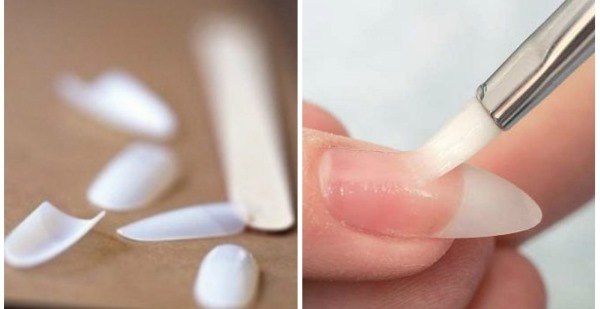
- Using this base, you can tighten the nail, which gives it subtlety and grace.
- The result is durable, beautiful lower arch, volumetric.
- Improves the appearance of very wide and down-growing nails.
Unlike tips, forms are characterized by the following disadvantages:
- Working with the material requires experience. Improper use makes the nail look unaesthetic.
- They are problematic when working on fingers with hard and large pads.
- Unacceptable for use on injured nails.
- Working with gel forms is more time consuming than with tips.
Varieties of tips
All tips for nail extension are similar in appearance and shape to a natural nail. They are used to shape a specific length of a manicure. When choosing a material, the structure and shape of the nail is taken into account. The tips fit perfectly, completely repeating the structure of the plate. A clear match will not deform the artificial nail.
By appointment
By appointment, tips are:
- strongly curved;
- universal.
The first type is designed to work on the nail bed, which has a strong bend. Universal ones are suitable for creating a manicure on problem nails.
By form
According to the form, varieties of tips are distinguished:
- Classic. Pack of 50 costs 250 rubles. Suitable for any type of nail plate due to its smooth bend. Widely used by professional manicure.
- Direct (contactless)... They provide for the absence of a contact zone, therefore they are used to create a French design. 100 copies cost around 150 rubles.
- Narrowed. Applied when making stylet, cat marigolds. 50 pcs. will cost 150 rubles.
- Almond-shaped. They are made both in a non-contact version and with a contact area. Almond-shaped. Pack of 50 costs from 130 rubles.
The tips have different lengths, which are indicated on the packaging. Manicurists use tips of the maximum length. The desired size is adjusted with special nippers.
By materials of manufacture
For the manufacture of tips use:
- ABS - plastic... The material is used for making classic type tips. Provides the finished product with high-quality grip and elasticity.
- Nylon. Resistant to mechanical damage and elastic.Nylon tips have a negative point - poor attachment to the nail.
- Propiflex... Elastic and stable, good contact with the nail, tenaciously fixed on the surface of the plate.
How to choose tips
The tips are easier to use and are recommended for beginners.
When purchasing material, the following criteria are taken into account:
- A thin substrate (tips) will give the nail a sophistication and naturalness.
- Quality tips are soft to the touch, but not brittle. If, when squeezing the tips with your fingers (so that it bends), white stripes appear, then it is not strong enough and it is possible that it will quickly become unusable.
- It is important to choose a safe material. When buying, it is impossible to do this without special equipment, therefore it is better to choose manufacturers that have proven themselves on the positive side.
- Women's nails have different shapes, when buying a substrate you should choose one that follows the shape of the nail.
- Outwardly, all substrates are different: transparent, colored and with a white tip. If the design of the nail is not defined, it is better to buy a transparent material, it is universal. White tips are used in French manicure.
Small substrates are commercially available. This material is practiced by specialists in manicure for nail design; it is not recommended for beginners to use it.
Required tools and materials
Everything for nail extension is available for sale, you can do without visiting a nail salon and build your nails yourself.
Basic starter set of materials for building on tips
For work you will need:
- Glue. The material differs in consistency. Liquid dries faster, sets. All brands of glue contain an antimicrobial component.
- Tip cutter... The length of the underlay is adjusted with this tool. Removing excess length with ordinary scissors is likely to damage the tips.
- Milling cutter - a power tool that corrects an extended nail. Can be used to remove cuticles, to remove gel or nail polish. The device is equipped with several attachments. The soft parts are used for working with the cuticle, the hard parts for sawing off the nail.
- Lamp (LED or UV). The apparatus is used for polymerization. The cost of LED lamps is more expensive, this technology is newer than UV lamps.
- Napkins (lint-free). Unlike cotton pads, lint-free wipes do not leave fine lint after use.
- Buff and files. The buff has the shape of a parallelepiped, each side of which is covered with a file with a low abrasiveness (hardness) coefficient.
- Brush... Natural hair tools will last longer.
- To choose: acrylic, gel, acrylate or biogel.
- Primer or degreaser... The product is intended for nail cleaning, degreasing and drying, prevents yellowness and delamination.
- Top. Color and shine fixer.
- Varnish for nails and decor items.
Each stage of work requires a file with a certain abrasiveness (hardness), which is measured in grits. The harder files are less abrasive.
Tool abrasiveness table:
| Grit | Application area |
| 80 | Working with the length and shape of the artificial nail |
| 150 | Working with a finished artificial nail |
| 240 | Formation of the length and shape of the biological nail |
| 400 | Removing gloss from natural nails, polishing |
| 900 | Polishing, gloss shaping |
What is needed for nail extension on forms?
Tool list:
- Dust brush.
- Tweezers.
- Shape correction files.
- Dehydrator.
- Cuticle spatula.
- Lamp.
- Grinding tool.
- Brushes.
- Forms.
Disposable or reusable forms can be purchased. Disposable ones are made of paper and are cheaper.
Reusable molds are more expensive, made of Teflon on a wire frame.

 Don't miss the most popular column article: How to draw monograms on nails step by step for beginners. Instruction with photo.
Don't miss the most popular column article: How to draw monograms on nails step by step for beginners. Instruction with photo.What is needed for gel nail extension?
The tools required for building are discussed above. The list of materials required for fixing a manicure and its even distribution includes the following tools.
For instance:
- Gel. The material from which the artificial nail is formed. When solidified, it forms a durable coating. The economy version is represented by a single-phase substance. Suitable for home use. The composition of the biphasic includes agents that protect the nail from fungus and flaking. Three-phase, in addition to the functions inherent in the previous raw materials, is used as a base, fixer and modeler.
- Primer. Translation of a word from English - primer. As in the case of building on tips, when working with gel, it is necessary to prepare the base and protect the nail plate from the effects of the gel components. There are 2 options: acidic, acid-free. The first type includes methacrylic acid. The substance opens the scales of the nail. The rough surface provides reliable adhesion of the nail to the applied materials. Acid-free gently affects the nail plate, improves and fixes the base.
- Degreaser. In everyday life, you can use ordinary alcohol.
- Oil will help get rid of dry cuticles after the procedure. You can buy: sesame, grape seed, sea buckthorn or castor.
- Paints (acrylic). This type of dye is used to create drawings on the nails.
- Decorations (stones, sparkles, rhinestones).
Everything for nail extension (tools and materials) can be purchased as a kit. Buying as a set is 25% cheaper than buying everything separately.
Preparing the nail plate for extension
Before building up, it is recommended to adhere to the following general rules:
- 4 days before the procedure, you should not do the edged classic and European manicure. These cosmetic services do not exclude damage to the cuticle, which makes further styling of the material difficult.
- The regrown part of the nail should be up to 3 mm long. This size allows you to determine its shape, select the appropriate overlays and ensure reliable fixation of the material.
- 12 hours before building up, exclude the application of cream on the hands, and 3 hours before the procedure refrain from contact with water.
The sequence of nail preparation includes 5 stages:
- Sanitization... The hands are treated with a disinfectant (alcohol, chlorhexidine).
- Cuticle treatment. The procedure involves softening it and gently pressing it against the nail base.
- Form creation... The grown edge of the nail is filed, giving the desired bend.
- Removing gloss... The procedure is carried out with a nail file with an abrasiveness of 240 or less. A thin layer of fat is removed. An overly grinded nail will not withstand lengthening, it can bend and break. The film is removed by moving the file from the cuticle to the edge of the nail. The removed coating will be restored in 40 minutes. The time to complete the main lengthening procedure should be calculated and the 4th stage of preparation should be performed immediately before it. The sawn layer is removed from the nail and fingers with a brush.
- Primer application... The action of the remedy is calculated for 30 minutes. Laying out the subsequent layers of the artificial nail begins immediately after degreasing. Lost time leads to the restoration of the biological nail plate, from which the future nail can quickly peel off.
Step-by-step instructions: building on tips
After preparing the nail plate for extension, in the case of performing the procedure using tips, the next steps are.
It:
- Selection of tips... The width of the product should match the width of the center of the nail plate. Ideally, the tips lie completely on the nail from corner to corner.
- Pasting... Glue is applied to the concave part with a brush over the entire area of the hole. Observing an angle of 45 degrees, begin gluing from the edge of the nail plate. 10 sec. the tipsu are kept pressed. If excess glue is released, wipe it with a lint-free cloth.
- Trim length... Correct the length with a tip cutter. It should be borne in mind that the subsequent steps of the manicure involve turning the nail with a file, which also reduces the length of the nail. Working with a tip cutter, it is better to cut with a margin.
- Formation... A file that does not exceed an abrasiveness of 100 grit is given a shape. At the same time, the joint is cut down, the transition is leveled. The biological nail is not affected at this stage. The surface of the workpiece should be smooth and stepless to the touch.
- Dust remaining on the nail is removed with a brush... A thin layer of degreaser is applied to the nail plate.
The tips are glued on. Further actions depend on the material chosen for building: gel or acrylic.
Instruction: building on the upper forms
Algorithm for building up on the upper forms:
- The usual preparation of the nail is carried out according to the scheme described above.
- Shapes are chosen that are similar in size to a biological nail. The most appropriate blank is selected for each nail. A small difference is undermined with a nail file. The finished forms are laid out in order so as not to confuse and not repeat the selection process.
- The nail is covered with a base gel.
- The area of the smile and the edge of the form (free) are filled with gel.
- The mold is polymerized for 20 seconds. in the lamp.
- The area of the mold that will be in contact with the nail is filled with gel, fitted and pressed with firm pressure.
- 30 sec. polymerize.
- The protruding excess of gel at the edges is removed.
- For 3 minutes. the fingers are placed in the lamp.
- The form is removed.
- With a file of no more than 100 grit, file the nail.
- Cover the nail with a finishing coat.

 Don't miss the most popular column article: How to build up your nails with gel polish. Instructions for nail extension for beginners. A photo.
Don't miss the most popular column article: How to build up your nails with gel polish. Instructions for nail extension for beginners. A photo.Instruction: building on liquid tips
Sequencing:
- A liquid tip is applied to the surface of the nail prepared for extension. The material is selected in advance according to the width of the nail, and the base layer is distributed along its inner part.
- With a brush, remove excess material that appears on the surface.
- If gel is used in the work, the next step is to dry it in a lamp. When using acrylic, drying is carried out in the air.
- After polymerization, the liquid types are removed, and the second layer is spread with a brush, while shaping the nail.
- The result obtained is again subjected to drying in a lamp (if using gel) or air-drying (if working with acrylic) for 2 minutes.
- The artificial nail is ready. They cover it with a finish or top and start the design.
Extension technology
Everything for nail extension is ready. Materials and tools were purchased. The nail plate has undergone conventional preparation and has been fitted with tips or molds. Having made a choice between gel or acrylic, you can proceed to the final stage.
Gel
The gel extension procedure includes:
- Application with a brush of the base material. Avoid contact of the gel with the skin and its leakage into the side rollers. Such consequences can be prevented by leaving 0.5 mm from the gel to the skin. At the same time, at this stage, it is necessary to form the architecture of the future nail. The finished base is dried for 3-5 minutes. in the lamp.
- The next layer is a modeling gel. The nail turns out to be firm and reliable if the procedures are repeated 2 times. Each layer should be made thin and held for 2 minutes. drying in a lamp. Decor elements are inserted between the layers and painting is carried out.
- The process of building up is completed by the application of the finishing gel and 2-minute drying in the lamp. Then they remove the sticky layer, hone the shape and get rid of surface irregularities.
Acrylic
Any type of manicure begins with the disinfection of the hands of the master and the client, the preparation of the plate, the selection of tips or forms.
After installing the base (tips, forms) when building with acrylic, the following manipulations are carried out:
- The surface of the nail is treated with a primer that promotes the adhesion of the future artificial nail to the biological one.
- The brush is moistened in liquid and then in acrylic powder. An acrylic ball is formed at the tip of the tool (material for the future nail).
- The ball is placed in the middle of the plate, and a nail is formed with light brush movements.
- The result obtained is filed into the desired shape. They start the process from the sides, then correct the tip and top.
- Buff is used to polish the surface until it shines and cut small scratches.
Acrylic used for nail extension in just 40-50 seconds. freezes in air. The material does not require drying in a lamp.
Article design: Anna Vinnitskaya
Video about the necessary materials for building
The most essential materials for nail extension at home:

